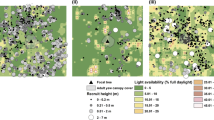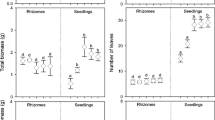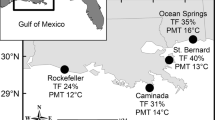Abstract
Current theory predicts that in low-density, seed-limited plant populations, seed predation will be more important than competition in determining the number of individuals that reach maturity. However, when plant density is high, competition for microsites suitable for establishment and growth is expected to have a relatively greater effect. This dichotomous perspective does not account for situations in which the risk of seed predation differs inside versus outside recruitment microsites. We report the results of a field experiment and sampling studies that demonstrate such an interaction between microsite quality and the risk of propagule predation in mangrove forests on the Caribbean coast of Panama, where it appears to play a key role in shaping the demography and dynamics of the mangrove, Rhizophora mangle. Rhizophora's water-borne propagules establish wherever they strand, but long-term sampling revealed that only those that do so in or near lightning-created canopy gaps survive and grow to maturity. These microsites afford better growth conditions than the surrounding understory and, as importantly, provide a refuge from predation by the scolytid beetle, Coccotrypes rhizophorae. This refuge effect was confirmed with a field experiment in which Rhizophora seedlings were planted at different positions relative to gap edges, from 5 m inside to 20 m outside the gap. Mortality due to beetle attack increased linearly from an average of 10% inside a gap to 72% at 20 m into the forest. The interaction between canopy disturbance and propagule predation may be having a large impact on the composition of our study forests. Being shade-tolerant, Rhizophora seedlings that escape or survive beetle attack can persist in the understory for years. However, the high rate of beetle-induced mortality effectively eliminates the contribution of advance regeneration by Rhizophora saplings to gap succession. This may explain why the shade-intolerant mangrove, Laguncularia racemosa, is able to co-dominate the canopy in low intertidal forests at our study sites.





Similar content being viewed by others
References
Andersen AN (1989) How important is seed predation to recruitment in stable populations of long-lived perennials? Oecologia 81:310–315
Atkinson TH, Peck SB (1994) Annotated checklist of the bark and ambrosia beetles (Coleoptera: Platypodidae and Scolytidae) of tropical southern Florida. Fla Entomol 77:313–329
Berenbaum MR (1987) Charge of the light brigade: phototoxicity as a defense against insects. ASC Symp Ser 339:206–216
Brokaw N, Busing RT (2000) Niche versus chance and tree diversity in forest gaps. Trends Ecol Evol 15:183–188
Brokaw NVL, Scheiner SM (1989) Species composition in gaps and structure of a tropical forest. Ecology 70:538–541, 569–576
Browne FG (1961) The biology of Malayan Scolytidae and Platypodidae. Malay For Rec 22
Chesson PL (1986) Environmental variation and the coexistence of species. In: Diamond J, Case TJ (eds) Community ecology. Harper and Row, New York, pp 240–256
Clarke PJ, Kerrigan RA (2000) Do forest gaps influence the population structure and species composition of mangrove stands in Northern Australia? Biotropica 32:642–652
Connell JH (1971) On the role of natural enemies in preventing competitive exclusion in some marine animals and rain forest trees. In: denBoer PJ, Gradwell GR (eds) Dynamics of populations. CAPD, Wageningen, The Netherlands, pp 298–312
Craighead FC (1971) The trees of South Florida, vol 1. The natural environments and their succession. University of Miami Press, Miami, Fla.
Crawley MJ (1989) Insect herbivores and plant population dynamics. Annu Rev Entomol 34:531–564
Crawley MJ (1992) Seed predators and plant population dynamics. In: Fenner M (ed) Seeds: the ecology of regeneration in plant communities. C.A.B. International, Wallingford, UK, pp 157–191
Davis JHJ (1940) The ecology and geologic role of mangroves in Florida. In: Tortugas laboratory papers, vol. 32. Carnegie Institute, Washington D.C., pp 303–412
Downum KR (1992) Light-activated plant defense. New Phytol 122:401–420
Downum KR, Wen JH (1995) The occurrence of photosensitizers among higher plants. ACS Symp Ser 616:135–143
Duke NC, Pinzón-M ZS (1992) Aging Rhizophora seedlings from leaf scar nodes: a technique for studying recruitment and growth in mangrove forests. Biotropica 24:173–186
Duke NC, Pinzón-M ZS (1993) Mangrove forests. In: Keller BD, Jackson JBC (eds) Long-term assessment of the oil spill at Bahía Las Minas, Panama, Synthesis report, vol II: technical section, OCS Study MMS 93–0048. U.S. Department of the Interior, Minerals Management Service, Gulf of Mexico OCS Region, New Orleans, La., pp 447–553
Ellison AM, Farnsworth EJ (1993) Seedling survivorship, growth, and response to disturbance in Belizean mangal. Am J Bot 80:1137–1145
Farnsworth EJ, Ellison AM (1996) Sun-shade adaptability of the red mangrove, Rhizophora mangle (Rhizophoraceae): changes through ontogeny at several levels of biological organization. Am J Bot 83:1131–1143
Farnsworth EJ, Ellison AM (1997) Global patterns of pre-dispersal propagule predation in mangrove forests. Biotropica 29:318–330
Fenner M (1985) Seed ecology. Chapman and Hall, London
Grime JP (1979) Plant strategies and vegetation processes. Wiley, New York
Hammond DS, Brown VK, Zagt R (1999) Spatial and temporal patterns of seed attack and germination in a large-seeded neotropical tree species. Oecologia 119:208–218
Harper JL (1977) Population biology of plants. Academic Press, New York
Hendrix SD (1988) Herbivory and its impact on plant reproduction. In: Lovett Doust J, Lovett Doust L (eds) Plant reproductive ecology. Oxford University Press, New York, USA, pp 246–263
Huffaker CB, Kennett CE (1959) A ten-year study of vegetational changes associated with the biological control of Klamath weed. J Range Manage 12:69–82
Hulme PE (1993) Post-dispersal seed predation by small mammals. Symp Zool Soc Lond 55:269–287
Hulme PE (1996) Natural regeneration of yew (Taxus baccata L.): Microsite, seed or herbivore limitation? J Ecol 84:853–861
Hulme PE (1997) Post-dispersal seed predation and the establishment of vertebrate dispersed plants in Mediterranean shrublands. Oecologia 111:91–98
Hurlbert SH (1984) Pseudoreplication and the design of ecological field experiments. Ecol Monogr 54:187–211
Imbert D, Menard S (1997) Vegetation structure and primary production in the mangrove of Fort-de-France Bay, Martinique, (F.W.I.). Biotropica 29:413–426
Janzen DH (1970) Herbivores and the number of tree species in tropical forests. Am Nat 104:501–528
Janzen DH (1971) Seed predation by animals. Annu Rev Ecol Syst 2:465–492
Jordal BH, Kirkendall LR (1998) Ecological relationships of a guild of tropical beetles breeding in Cecropia petioles in Costa Rica. J Trop Ecol 14:153–176
Louda SM (1982) Distribution ecology: variation in plant recruitment over a gradient in relation to insect seed predation. Ecol Monogr 52:25–41
Louda SM (1983) Seed predation and seedling mortality in the recruitment of a shrub, Haplopappus venetus (Asteraceae) along a climatic gradient. Ecology 64:511–521
Louda SM (1989a) Predation in the dynamics of seed regeneration. In: Leck MA, Parker VT, Simpson RL (eds) Ecology of soil seed banks. Academic Press, San Diego, Calif., pp 25–52
Louda SM (1989b) Differential predation pressure: a general mechanism for structuring plant communities along complex environmental gradients? Trends Ecol Evol 4:158–159
Louda SM, Potvin MA (1995) Effect of inflorescence-feeding insects on the demography and lifetime fitness of a native plant. Ecology 76:229–245
Louda SM, Rodman JE (1996) Insect herbivory as a major factor in the shade distribution of a native crucifer (Cardamine cordifolia A. Gray, bittercress). J Ecol 84:229–237
Louda SM, Dixon PM, Huntly NJ (1987) Herbivory in sun versus shade at a natural meadow-woodland ecotone in the Rocky Mountains. Vegetatio 72:141–150
Maiorana VC (1981) Herbivory in sun and shade. Biol J Linn Soc 15:151–156
Marks PL, Gardescu S (1998) A case study of sugar maple (Acer saccharum) as a forest seedling bank species. J Torrey Bot Soc 125:287–296
Maron JL, Simms EL (1997) Effect of seed predation on seed bank size and seedling recruitment of bush lupine (Lupinus arboreus). Oecologia 111:76–83
McKee KL (1995) Seedling recruitment patterns in a Belizean mangrove forest: Effects of establishment ability and physico-chemical factors. Oecologia 101:448–460
Odum WE, McIvor CC, Smith TJI (1982) The ecology of the mangroves of south Florida: a community profile. U.S. Fish and Wildlife Service, Office of Biological Services, Washington, D.C.
Onuf CP, Teal JM, Valiela I (1977) Interactions of nutrients, plant growth and herbivory in a mangrove ecosystem. Ecology 58:514–526
Paijmans K, Rollet B (1977) The mangroves of Galley Reach, Papua New Guinea. For Ecol Manage 1:119–140
Poulson TL, Platt WJ (1996) Replacement patterns of beech and sugar maple in Warren Woods, Michigan. Ecology 77:1234–1253
Rabinowitz D (1978) Dispersal properties of mangrove propagules. Biotropica 10:47–57
Schaeffer-Novelli Y, Cintron-Molero G, Adaime RR (1990) Variability of mangrove ecosystems along the Brazilian coast. Estuaries 13:204–218
Schemske DW (1984) Population structure and local selection in Impatiens pallida (Balsaminaceae), a selfing annual. Evolution 38:817–832
Sherman RE, Fahey TJ, Battles JJ (2000) Small-scale disturbance and regeneration dynamics in a neotropical mangrove forest. J Ecol 88:165–178
Smith SM, Lee DW (1999) Effects of light quantity and quality on early seedling development in the red mangrove, Rhizophora mangle L. Bull Mar Sci 65:795–806
Smith SM, Snedaker SC (2000) Hypocotyl function in seedling development of the red mangrove, Rhizophora mangle L. Biotropica 32:677–685
Smith TJ III (1992) Forest structure. In: Robertson AI, Alongi DM (eds) Tropical mangrove ecosystems. American Geophysical Union, Washington, D. C., pp 101–136
Smith TJ III, Robblee MB, Wanless HR, Doyle TW (1994) Mangroves, hurricanes, and lightning strikes: assessment of Hurricane Andrew suggests an interaction across two differing scales of disturbance. Bioscience 44:256–262
Sousa WP, Mitchell BJ (1999) The effect of seed predators on plant distributions: Is there a general pattern in mangroves? Oikos 86:55–66
Sousa WP, Kennedy PG, Mitchell BJ (2003) Propagule size and predispersal damage by insects affect establishment and early growth of mangrove seedlings. Oecologia 135:564–575
Thompson WA, Moser JC (1986) Temperature thresholds related to flight of Dendroctonus frontalis Zimm. (Coleoptera: Scolytidae). Agronomie 6:905–910
Tomlinson PB (1986) The botany of mangroves. Cambridge University Press, Cambridge, UK
Uhl C, Clark K, Dezzeo N, Maquirino P (1988) Vegetation dynamics in Amazonian treefall gaps. Ecology 69:751–763
Warner RR, Chesson PL (1985) Coexistence mediated by recruitment fluctuations: a field guide to the storage effect. Am Nat 125:769–787
Winer BJ, Brown DR, Michels KM (1991) Statistical principles of experimental design, 3rd edn. McGraw-Hill, New York
Wood SL (1982) The bark and ambrosia beetles of North and Central America (Coleoptera: Scolytidae), a taxonomic monograph. Great Basin Nat Mem 6:1–1359
Wood SL (1986) A reclassification of the genera of Scolytidae (Coleoptera). Great Basin Nat Mem 10:1–126
Woodruff RE (1970) A mangrove borer, Poecilips rhizophorae (Hopkins) (Coleoptera: Scolytidae). Fla Dept Agric Consumer Serv Div Plant Indust Entomol Circ 98:1–2
Acknowledgements
We are very grateful for the field and laboratory assistance provided by J. Abraham, E. Adams, A. Beaulaurier, W. Bragg, L. Chan, C. Coldewey, A. Cundiff, J. Dunn, J. Gunn-Glanville, N. Hausmann, I. Herriott, D. Hitchcock, P. Huang, J. Kemp, P. Kennedy, S. Lehigh, J. Levine, G. Lopez, H. Malhi, A. McCray, J. McGraw, K. Marsee, D. Matias, G. Mendoza, M. Metz, A. Minn, C. Nerney, J. Parrent, G. Peracca, S. Poetker, R. Raban, J. Roelands, C. Sagers, J. Shors, A. Smyth, G. Sousa, J. Steele, B. Tonkonogy, M. Venkatesan, J. Walker, J. Williams, and H. Wright, and for the logistical assistance provided by S. Lemos, F. Sanchez, R.Thompson, and the Visitors Services Office of the Smithsonian Tropical Research Institute (S.T.R.I.). J. Abraham, A. Beaulaurier, A. Ellison, N. Hausmann, P. Kennedy, J. McGraw, M. Metz, and J. Skene provided helpful comments on the manuscript, J. Battles and E. Simms suggested key references, L. Bjostad and K. Downum enlightened us on the possible role of phototoxins in defending Rhizophora against beetle attacks, and N. Hausmann and G. Roderick expertly helped produce Fig. 1. Special thanks to M. Geber for supplying her light gap sampling data from 1985: the seed from which our study has grown. We thank S.T.R.I. for allowing us to use the Galeta Marine Laboratory. This study was supported by National Science Foundation grants DEB-9221074, DEB-9615887, and DEB-0108146 to W.P.S., by the Committee for Research, University of California at Berkeley, and by the Miller Institute for Basic Research in Science. It was conducted under research permits from the Panamanian National Institute for Renewable Natural Resources. We especially thank the Republic of Panama for preserving their forests and making them available for study.
Author information
Authors and Affiliations
Corresponding author
Rights and permissions
About this article
Cite this article
Sousa, W.P., Quek, S.P. & Mitchell, B.J. Regeneration of Rhizophora mangle in a Caribbean mangrove forest: interacting effects of canopy disturbance and a stem-boring beetle. Oecologia 137, 436–445 (2003). https://doi.org/10.1007/s00442-003-1350-0
Received:
Accepted:
Published:
Issue Date:
DOI: https://doi.org/10.1007/s00442-003-1350-0




